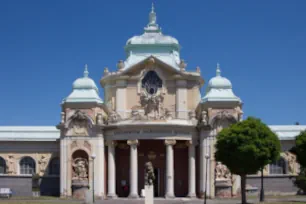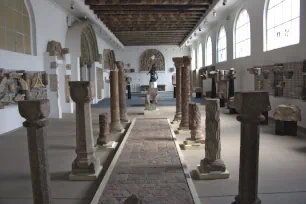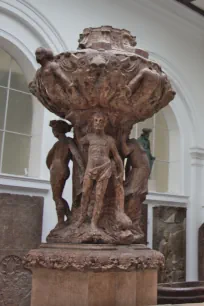The Lapidarium is a museum home to the largest collection of stone sculptures in the Czech lands, dating from the 11th century all the way to the 19th century. It houses works that were under threat from demolition or risked being damaged by the elements, such as the original statues from the Charles Bridge.
The Building

The museum is housed in an ornate building on Výstaviště, exhibition grounds that first opened to the public in 1891 to host the General Land Centennial Exhibition, a world fair that was held that year in Prague. It was built as a pavilion for the Retrospective Exhibition, which displayed weapons, armor and monuments from prehistoric times to the times of the Austrian Hungarian Empire.
The building was designed by architect Anonín Wiehl as a Neo-Renaissance structure with three wings around two courtyards. Its exterior was drastically altered in 1908, when a Baroque roof was added and the exterior was embellished with Art Nouveau decoration by the Czech sculptor František Hergesel.
The Museum
History

The Lapidarium collection was officially formed in 1898 when it was first exhibited on the grounds of Výstaviště. A permanent exhibition opened in 1905 to the public in the same building but it closed in 1914 due to the outbreak of the First World War. A new permanent exhibition opened in 1932 but had to close seven years later due to the outbreak of the Second World War. It reopened temporarily during the Communist era but it once again had to close in 1967, this time because the building had fallen into disrepair. The museum in its current form stems from 1993, when it opened after a renovation of the museum building was completed.
Collection



The collection of the Lapidarium contains some 3,000 works of stone, of which about 400 are on display across eight rooms. They originate mostly from Prague or Central Bohemia.
Some of the monuments, memorials and tombstones on display were saved from destruction when whole neighborhoods were torn down when the historic center of Prague was being redeveloped. Others were moved here because they stood in the way of tram lines or new roads. Others again were moved inside to protect them from the weather. And finally, a lot of the monuments celebrating the Habsburg Empire were removed from the streets for political reasons.
The works are arranged chronologically, starting in the first room with medieval sculpture and ending with 19th-century sculptures in the seventh and eighth room.
Highlights
The main highlight in the first room is the group of fragments of a tympanum from the castle of Oldříš. It is the oldest surviving relief sculpture in the Czech lands, and probably dates from around the year 1100. There are also a lot of tombstones in this room, including a set of eight carved tombstones for Abbots from Ostrov u Davle from around the 1300s.
In the second room you find sculptures from Petr Parléř (Peter Parler) which originally decorated the Old Town Bridge Tower. Room three is dominated by the remains of the magnificent Renaissance-style Krocín fountain in red marble that once adorned Old Town Square. On the same square stood the Marian Column, created in 1650 by Jan Jiří Bendl. This symbol of Habsburg oppression was destroyed by nationalists in 1818 (but replaced by a new column in 2020). Of the original, only the archangel statues and the head of the Virgin Mary survived; they are on display in room four.
The next room shows original sculpture groups that once stood on the Charles Bridge. In room six you can see a gilded statue of the Virgin Mary from the Marian Column on Prague’s Castle Square as well as an equestrian statue of St. Wenceslas. Room seven contains a series of allegorical statues from the Kinský Palace at the Old Town Square and in the last room you find two of the oldest bronze monuments in Prague: the equestrian statue of Emperor Francis I and a large monument to Marshal Radetzky.
- Next: Vojan Park
- More Sights & Attractions in Prague

